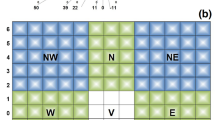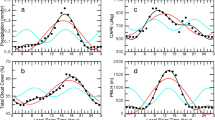Abstract
Satellite observations have recently revealed a surprising imprint of the 11-year solar cycle on global low cloud cover. The cloud data suggest a correlation with the intensity of galactic cosmic rays. If this apparent connection between cosmic rays and clouds is real, variations of the cosmic ray flux caused by long-term changes in the solar wind could have a significant influence on the global energy radiation budget and the climate. However a direct link between cosmic rays and clouds has not been unambiguously established and, moreover, the microphysical mechanism is poorly understood. New experiments are being planned to find out whether cosmic rays can affect cloud formation, and if so how.
Similar content being viewed by others
References
Anderson, R. J., Miller, R. C., Kassner, J. L. Jr., and Hagen, D. E.: 1980, ‘A study of homogeneous condensation-freezing nucleation of small water droplets in an expansion cloud chamber’, J. Atmospheric Sciences 37, No. 11, 2508–2520.
Arnold, F.: 1980, ‘Multi-ion complexes in the stratosphere: implications for trace gases and aerosols’, Nature 284, 610.
Bricard, J. et al.: 1968, ‘Formation and evolution of nuclei of condensation that appear in air initially free of aerosols’, J. Geophys. Res. 73, 4487.
Cheng, C.-C., Tao, C.-J., and Shu, H.-J.: 2000, ‘Heterogeneous nucleation of n-butanol vapour on sub-micrometer charged and neutral particles of lactose and monosodium glutamate’, J. Colloid Interface Sci. 224, 11.
Clarke, A.D. et al.: 1998, ‘Particle nucleation in the tropical boundary layerand its coupling tomarine sulfur sources’, Science 282, 89.
CLOUD collaboration (B. Fastrup et al.): 2000, CERN proposal SPSC/P317, SPSC 2000-021.
Eichkorn, S., Wohlfrom, K. H., and Arnold, F.: 2000, ‘Massive ion detection in the upper troposphere: implications for aerosol particle formation via ion-induced nucleation’, poster presented at the EGS General Assembly, The Hague.
Fröhlich, C.: 2000, ‘Observations of Irradiance Variability’, Space Sci. Rev., this volume.
Harrison, R.G.: 2000, ‘Cloud formation and the possible significance of charge for atmospheric condensation and ice nuclei’, Space Sci. Rev., this volume.
Hartmann, D. L.: 1993, ‘Radiative effects of clouds on Earth's climate, in P. V. Hobbs (ed.), Aerosol-Cloud-Climate Interactions, International Geophysics Series, Vol. 54, Academic Press Inc., San Diego, 151.
Hõrrak, U., Salm, J., and Tammet, H.: 1998, Bursts of intermediate ions in atmospheric air, J. Geophys. Res. 103 D12, 13909.
Kernthaler, S. C., Toumi, R. and Haigh, J. D.: 1999, ‘Some doubts concerning a link between cosmic ray fluxes and global cloudiness’, Geophys. Res. Lett. 26, 863.
Larkin, A., Haigh, J. D., and Djavidnia, S.: 2000, ‘The effect of UV Irradiance Variations on the Earth's Atmosphere’, Space Sci. Rev., this volume.
Lean, J. L.: 2000, ‘Short term, indirect indices of solar variability’, Space Sci. Rev., this volume.
Lockwood, M., Stamper, R., and Wild, M.N.: 1999, ‘A doubling of the Sun's coronal magnetic field during the past 100 years’, Nature 399, 437.
Mann, M. E., Bradley, R. S., and Hughes, M. K.: 1999, ‘Northern hemisphere temperatures during the past millennium: inferences, uncertainties and limitations’, Geophys. Res. Lett. 26, 759.
Marsh, N., and Svensmark, H.: 2000a, ‘Cosmic Rays, Clouds and Climate’, Space Sci. Rev., this volume.
Marsh, N., and Svensmark, H.: 2000b, ‘Low cloud properties influenced by solar activity’, Geophys. Res. Lett., submitted.
Pruppacher, H. R., and Klett, J. D.: 1997, Microphysics of clouds and precipitation, 2nd ed., Kluwer Academic Publishers, The Netherlands.
Raes, F., and Janssens, A.: 1985, ‘Ion-induced aerosol formation in a H2-H2SO4 system-I. Extension of the classical theory and search for experimental evidence’, J. Aerosol Sci. 16, 217.
Raes, F., Janssens, A., and Dingenen, R.V.: 1986, ‘The role of ion-induced aerosol formation in the lower atmosphere’, J. Aerosol Sci. 17, 466.
Reid, G.C.: 2000,’ Solar Varibility and the Earth's Climate: Introduction and Overview’, Space Sci. Rev., this volume.
Rosenfeld, D.: 2000, ‘Suppression of rain and snow by urban and industrial air pollution’, Science 287, 1793.
Solanki, S.K.: 2000, ‘Reconstruction of past solar irradiance’, Space Sci. Rev., this volume.
Stozhkov, Yu. I., et al.: 1985, ‘Rainfalls during great Forbush decreases’, Il Nuovo Cimento 18C, 335.
Svensmark, H.: 1998, ‘Influence of cosmic rays on the Earth's climate’, Phys. Rev. Lett. 81, 5027.
Svensmark, H., and Friis-Christensen, E.: 1997, ‘Variation in cosmic ray flux and global cloud coverage—a missing link in solar-climate relationships’, Journal of Atmospheric and Solar-Terrestrial Physics 59, 1225.
Tinsley, B.A.: 2000, ‘Influence of solar wind on the global electric circuit, and inferred effects on cloud microphysics, temperature and dynamics in the troposphere’, Space Sci. Rev., this volume.
Turco, R. P., Zhao, J.-K., and Yu, F.: 1998, ‘A new source of tropospheric aerosols: ion-ion recombination’, Geophys. Res. Lett. 25, 635.
Turco, R. P., Zhao, J.-K., and Yu, F.: 2000, ‘Ultrafine aerosol formation via ion-mediated nucleation’, Geophys. Res. Lett. 27, 883.
Verschuren, D., Laird, K., and Cumming, B.: 2000, ‘Rainfall and drought in equatorial East Africa during the past 1100 years’, Nature 403, 410.
Veretenenko, S. V., and Pudovkin, M. I.: 1999, ‘Variations of solar radiation input to the lower atmosphere associated with different helio/geophysical factors’, J. Atmos. Solar-Terrestrial Phys. 61, 521.
Vohra, K. G., Subba Ramu M. C., and Muraleedharan, T. S.: 1984, ‘An experimental study of the role of radon and its daughter products in the conversion of sulphur dioxide into aerosol particles in the atmosphere’, Atmospheric Environment 18, 1653.
Waibel, A. E., Peter, T., Carslaw, K. S., Oelhaf, H., Wetzel, G., Crutzen, P. J., Pöschl, U., Tsias, A., Reimer, E., and Fischer, H.: 1999, ‘Arctic ozone loss due to denitrification’, Science 283, 2064-2069.
Yu, F., and Turco, R. P.: 2000, ‘From molecular clusters to nanoparticles: the role of ambient ionization in tropospheric aerosol formation’, J. Geophys. Res., submitted.
Author information
Authors and Affiliations
Rights and permissions
About this article
Cite this article
Kirkby, J., Laaksonen, A. Solar Variability and Clouds – Discussion Session 3c. Space Science Reviews 94, 397–409 (2000). https://doi.org/10.1023/A:1026712518869
Issue Date:
DOI: https://doi.org/10.1023/A:1026712518869




